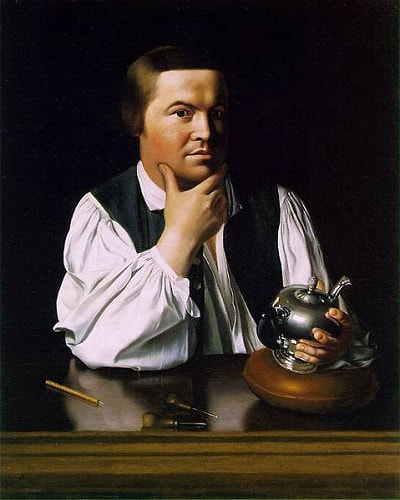Paul Revere's Join or Die
|
Franklin’s cartoon had been redrawn and reprinted throughout the colonies after the passing of the Stamp Act in 1765. It became a powerful symbol of Colonial unity and resistance to British oppression. On July 7, 1774, Paul Revere altered the cartoon to fit the masthead of his newspaper, The Massachusetts Spy. In the image shown below, I have combined Paul Revere’s Join, or Die with another American icon, the nine red and white stripes which represent the flag of the secret organization called The Sons of Liberty. History is unable to determine the group's exact date of origin, but it's estimated to have formed in Boston after the passing of the Stamp Act in 1765. Their membership spread like wildfire among the colonies because their sole purpose was to erode British rule. The organization was initially based on "no taxation without representation." They successfully defeated the Stamp Act and then began to focus their attention on American Independence. Most historians would agree that without this underground movement in the colonies the American Revolution would have never have gathered the necessary momentum it needed to declare Independence from Great Britain. They were also responsible for the Boston Tea Party. Some of their noteworthy members included John Adams, Samuel Adams, Benedict Arnold, John Hancock, Patrick Henry, Paul Revere, Benjamin Rush, Joseph Warren and Oliver Wolcott. Nine stripes were chosen for their flag because it represented the first nine protesting colonies , also referred to as the Loyal Nine, that participated in the Stamp Act Congress of 1765. The British referred to this flag as the "Rebellious Stripes." They eventually adopted a flag with thirteen horizontal red and white stripes. This was the same flag that appeared on merchant ships during the Revolution. It's been documented that they held their meetings in secrecy; at night, in Boston's Hanover Square, under a 120 year old elm tree. This tree was eventually referred to as the "Liberty" tree. On the night the Sons of Liberty successfully repealed the Stamp Act, they hung a large number of lanterns on the Liberty Tree to celebrate their victory. The British eventually cut the tree down, but this had no effect on their plight. It only served to emolden their quest to become a nation of free men. Throughout the colonies the Sons of Liberty would erect a Liberty Pole to signal a gathering. They would fly the "Rebellious Stripes" or place a "liberty cap" atop the pole to signal a protest and bold disobedience towards the British. The British cut the Liberty Poles down, but they couldn't stop the colonists resolve for freedom and independence. |
.
. |
Paul Revere's "Join or Die"/Sons of Liberty Flag with musket balls
52"w x 17"h - $625
38"w x 11.5"h - $395
Click button below to see available variations and place your order with just a $50 deposit
52"w x 17"h - $625
38"w x 11.5"h - $395
Click button below to see available variations and place your order with just a $50 deposit

Supported Browsers: Chrome, Firefox, Safari, Microsoft Edge
THANK YOU VERY MUCH FOR VISITING MY SITE!






